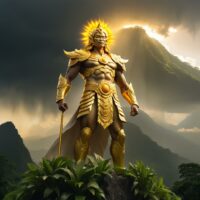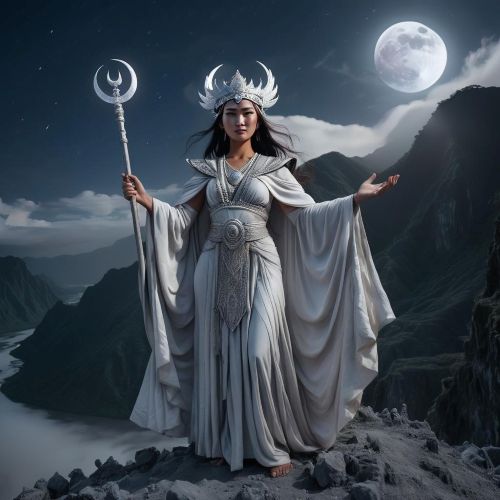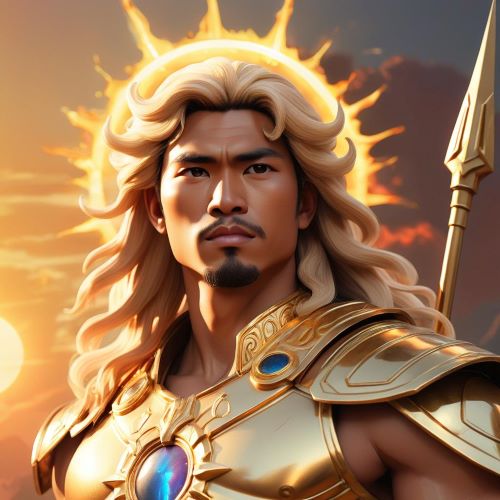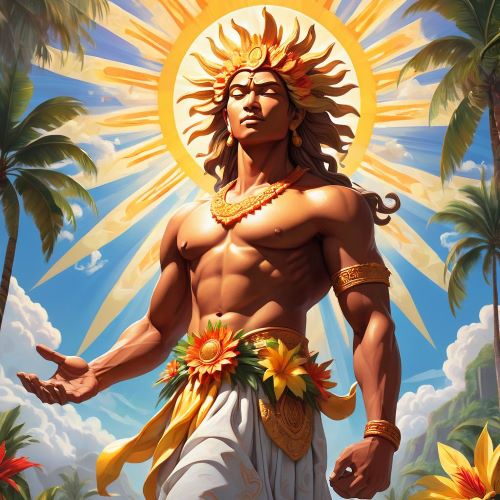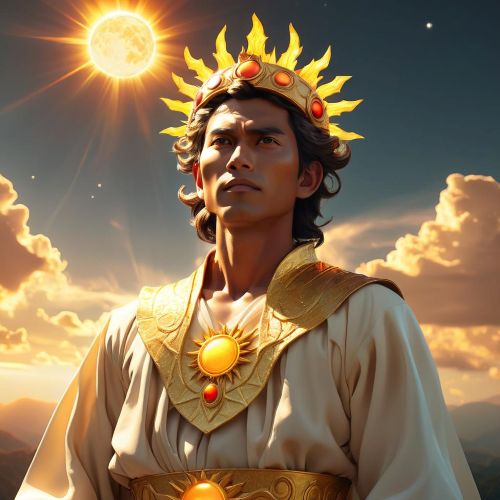Aring Sinukuan : The Sun God
Listen
At a glance
| Description | |
|---|---|
| Origin | Philippine Mythology |
| Classification | Gods |
| Family Members | Munag Sumalâ, Gatpanapun, Lakandanup (Children) |
| Region | Philippines |
| Associated With | Sun, War, Death |
Aring Sinukan
Introduction
Aring Sinukuan, also called Apung Sinukuan, is a legendary figure from Kapampangan mythology deeply associated with the sun, war, death, and agricultural wisdom. Revered as the guardian deity of Mount Arayat in Pampanga, Philippines, his story is a powerful reflection of the precolonial Kapampangan worldview. Sinukuan’s mythology embodies themes of cosmic authority, moral judgment, and harmony with nature. His enduring legacy, though reshaped by centuries of colonization, continues to capture the imagination of storytellers, scholars, and cultural advocates alike.
Physical Traits
Aring Sinukuan is described as a towering and radiant figure whose form seems to merge with the elements. With skin glinting like burnished bronze and a form wreathed in light, he is the embodiment of solar power and divine masculinity. His presence atop Mount Arayat is said to cast a spiritual glow over the region. Some depictions imagine him as a youthful, handsome figure whose strength and beauty rival the gods of Olympus. Yet his physical form is fluid—at times seen as a gust of wind or as a lightning-struck silhouette on the mountain. These ethereal attributes emphasize his dominion over both the seen and unseen forces of nature.
Family
The familial legends surrounding Aring Sinukuan are as rich as his divine attributes. He is known as the father of powerful offspring who represent various times of the day. Munag Sumalâ heralds dawn, shimmering like gold; Lakandanup, representing the scorching noon, is often viewed as a mysterious and dangerous force; and Gatpanapun embodies the gentle light of the afternoon, suggesting introspection and nobility. Other stories link Sinukuan romantically to Maria Makiling, a fellow guardian spirit, with their daughters symbolizing traditional Kapampangan values of beauty, grace, and virtue. These familial ties add complexity to his mythos, positioning him as both a stern patriarch and a gentle provider.
Other names
Aring Sinukuan is known by several alternative names and titles that reflect both reverence and adaptation over time. “Apung Sinukuan” underscores his role as a respected elder and spiritual authority. The older form “Suku,” meaning “he to whom others surrender,” emphasizes his role as a sovereign force. During Spanish colonization, the name was feminized into “Maria Sinukuan,” part of a broader effort by missionaries to tame indigenous male deities by transforming them into more palatable female nature spirits. This colonial reinterpretation shifted perceptions but never fully erased his deeper mythological essence, which persists in local oral traditions.
Powers and Abilities
Aring Sinukuan commands a wide spectrum of supernatural powers. As a god of war, he once inspired warriors and kings, offering divine favor in times of conflict. In his role as a death deity, he weighs the souls of the departed, ensuring justice and cosmic balance. As a teacher of agriculture and industry, Sinukuan is credited with bestowing crucial skills like rice farming, metallurgy, and carpentry upon early Kapampangans. He can summon storms, command lightning, and even alter landscapes, as seen in tales where he moved entire mountains or forged paths of gold. His abilities also extend to moral transformation—those who approach him with greed are humbled, and the virtuous are rewarded. This dual role as protector and punisher makes him a figure of awe and moral authority.
Modern Day Influence
Despite the decline of indigenous worship practices, Aring Sinukuan remains an enduring cultural icon. His name appears in everything from bottled beverages to newspapers and television characters, proving his adaptability in modern Filipino life. He has inspired novels, comic books, and festival celebrations such as the annual Sinukwan Festival in San Fernando, which honors Kapampangan heritage and precolonial mythology. Even in folk Catholicism, aspects of Sinukuan’s character survive—merged with saints like Michael the Archangel in the form of protective amulets and rituals. Digital artists and storytellers now reinterpret his myth through animation, AI-generated art, and online folklore hubs, giving new life to one of the Philippines’ most powerful mythic figures.
Aring Sinukuan’s story is more than a relic of the past—it’s a testament to the resilience of indigenous identity and a call to reconnect with ancestral knowledge in a rapidly modernizing world.
Related Images
Source
Clark, J. (2017). Formation of the World: Kapampangan Mythology. The Aswang Project. Retrieved from https://www.aswangproject.com/kapampangan-mythology/
Eugenio, D. L. (2010). Philippine Folk Literature: The Myths. Quezon City: University of the Philippines Press.
Mallari, J. C. (2009). King Sinukwan Mythology and the Kapampangan Psyche. ResearchGate. Retrieved from https://www.researchgate.net/publication/49620014_King_Sinukwan_Mythology_and_the_Kapampangan_Psyche
Nicdao, A. (1917). Pampangan Folklore. Manila: Philippine Education Company.
Bigwas. (2019). Who is Aring Sinukuan?. Retrieved from https://www.bigwas.com/2019/06/who-is-aring-sinukuan.html
Encyclopedia Mythica. (1996). Sinukuan. Retrieved from https://pantheon.org/articles/s/sinukuan.html
Liquisearch. (n.d.). Kapampangan Deities. Retrieved from https://www.liquisearch.com/deities_of_philippine_mythology/list_of_gods_and_goddesses/kapampangan_deities
Frequently Asked Questions
What is lorem Ipsum?
I am text block. Click edit button to change this text. Lorem ipsum dolor sit amet, consectetur adipiscing elit. Ut elit tellus, luctus nec ullamcorper mattis, pulvinar dapibus leo.
What is lorem Ipsum?
I am text block. Click edit button to change this text. Lorem ipsum dolor sit amet, consectetur adipiscing elit. Ut elit tellus, luctus nec ullamcorper mattis, pulvinar dapibus leo.
What is lorem Ipsum?
I am text block. Click edit button to change this text. Lorem ipsum dolor sit amet, consectetur adipiscing elit. Ut elit tellus, luctus nec ullamcorper mattis, pulvinar dapibus leo.
What is lorem Ipsum?
I am text block. Click edit button to change this text. Lorem ipsum dolor sit amet, consectetur adipiscing elit. Ut elit tellus, luctus nec ullamcorper mattis, pulvinar dapibus leo.
What is lorem Ipsum?
I am text block. Click edit button to change this text. Lorem ipsum dolor sit amet, consectetur adipiscing elit. Ut elit tellus, luctus nec ullamcorper mattis, pulvinar dapibus leo.


